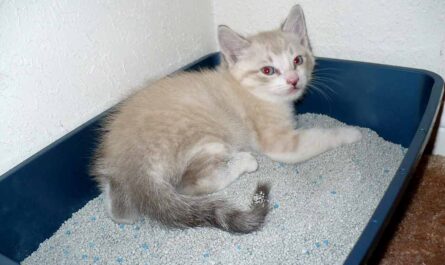How to tell if your cat has tapeworms? Ever had that sinking feeling when you discover wiggly, rice-like segments near your cat’s rear end? Yep, those could be tapeworms, unwelcome guests in your feline friend’s digestive system. But don’t panic! While tapeworms sound scary, with a little knowledge and some proactive steps, you can help your kitty feel purr-fect again in no time.
This article is your guide to understanding tapeworms in cats. We’ll demystify their lifecycle, explore the different types, and bust some common myths. We’ll also equip you with the knowledge to recognize the signs, navigate diagnosis and treatment, and ultimately, keep those pesky parasites at bay. So, grab a cup of catnip tea (for you, of course!), cuddle up with your furry friend, and let’s dive into the world of tapeworms!
Demystifying the Tiny Terrorists: Tapeworms 101
Imagine a microscopic hitchhiker hitching a ride on a flea or rodent. This tiny traveler called a tapeworm egg, gets swallowed by your cat, transforming into a segmented worm that latches onto their intestines, happily munching on nutrients. Sounds like a scene from a sci-fi movie, right? But tapeworms are, unfortunately, a reality for many cats.
There are two main types of tapeworms affecting our feline companions:
- Dipylidium caninum: These guys are transmitted through fleas, so if your cat has a flea problem, they’re more likely to become unwelcome guests. They’re usually harmless but can cause mild digestive upset.
- Taenia taeniaeformis: These tapeworms come courtesy of infected rodents, like mice. While less common, they can be more serious, causing weight loss and other health issues.
Now, let’s dispel some common myths:
- Myth: Tapeworms only affect outdoor cats. Fact: Even indoor cats can get tapeworms if they ingest infected fleas or come into contact with contaminated surfaces.
- Myth: Tapeworms always cause weight loss. Fact: While some tapeworms can lead to weight loss, others might not cause any noticeable symptoms. That’s why regular checkups and awareness are key.
Remember, this is just the beginning of our journey into the world of tapeworms. Stay tuned for the next part, where we’ll explore the signs to watch out for and how to get your cat the help they need!
Recognizing the Signs: Tiny Detectives on the Case!
Just like tiny detectives sniffing out clues, some telltale signs might indicate your cat has unwelcome tapeworm guests. Here’s what to keep your eyes peeled for:
- The Smoking Gun: Ever spotted tiny, white, rice-like segments around your cat’s backside or in their litter box? Those, unfortunately, could be tapeworm segments, which detach from the main worm and are shed in their stool. Yuck, right? But catching these little “clues” early is crucial!
- Scooting Surprise: Does your normally graceful kitty suddenly develop a penchant for scooting their bum across the floor? While this behavior can have various causes, it can also be a sign of irritation caused by tapeworms around their rear end.
- Appetite Antics: Have you noticed your cat’s appetite fluctuating? They might be eating more than usual but still appear thin, or their interest in food might seem to wane. Tapeworms can absorb nutrients your cat needs, impacting their appetite and weight.
- Energy Enigma: Is your usually sprightly kitty acting lethargic or less playful? A tapeworm infection can drain their energy levels, making them less interested in their usual antics.
Remember, these signs can also have other explanations, so it’s crucial to talk to your veterinarian if you notice any of them. They can run simple tests to confirm the presence of tapeworms and recommend the best course of treatment.
The Importance of Early Action: Why Your Swiftness Matters!
Think of tapeworms like unwelcome party guests – the sooner you get rid of them, the better! While tapeworms typically don’t cause serious health problems for healthy cats, leaving them untreated can lead to complications like:
- Nutritional deficiencies: As mentioned earlier, tapeworms steal nutrients your cat needs, potentially hindering their growth and development.
- Secondary infections: Open wounds caused by tapeworm segments around the rear end can become infected if left untreated.
- Discomfort and distress: The irritation caused by tapeworms can be quite uncomfortable for your feline friend, making them restless and unhappy.
By acting promptly, you can ensure your cat’s comfort, well-being, and continued good health. Plus, early detection and treatment prevent the spread of tapeworm eggs, keeping your furry friend and your home healthier in the long run.
So, don’t hesitate to reach out to your veterinarian if you suspect your cat might have tapeworms. Remember, early action is key to a purrfectly healthy outcome!
Next Up: We’ll explore what you can do if your cat does have tapeworms and how to prevent future infestations. Stay tuned for more helpful tips and information!
Diagnosis and Treatment: Partnering with Your Vet for Speedy Recovery
If you suspect your feline friend might have tapeworms, don’t worry! Early detection and treatment can quickly get them back to playful purrs and zoomies. The most important step is to partner with your veterinarian for an accurate diagnosis and personalized treatment plan. They’re your kitty’s champion in this, armed with the knowledge and tools to help them feel their best again.
Consulting Your Cat’s Trusted Guide: Your Veterinarian
Think of your veterinarian as your cat’s detective, using their expertise to unravel the mystery of their discomfort. They’ll ask detailed questions about your kitty’s habits, appetite, and recent activities, piecing together clues to understand what might be going on. Don’t hesitate to share any observations you’ve made, however big or small – every detail can be valuable in guiding them toward the right diagnosis.
Shining a Light: Diagnostic Procedures
To confirm the presence of tapeworms, your veterinarian might use a few different tools. A common method is a fecal examination, where a tiny sample of your cat’s stool is examined under a microscope to look for tapeworm segments or eggs. Sometimes, additional tests like bloodwork or X-rays might be needed, but your veterinarian will only recommend these if they believe it’s necessary for your cat’s specific situation.
Waving Goodbye to Unwanted Guests: Treatment Options
Once your veterinarian confirms the presence of tapeworms, they’ll recommend the most effective treatment for your cat. This usually involves medication in the form of a tablet or topical application. Different types of medication target different types of tapeworms, so your veterinarian will choose the one that’s best suited for your feline friend’s specific case. Remember, never administer any medication to your cat without consulting your veterinarian first, as even over-the-counter remedies can be harmful if not chosen correctly.
Keeping Things Cozy After the Battle: Post-Treatment Care
After your cat’s tapeworm eviction, your veterinarian will likely recommend some follow-up steps to ensure they stay worm-free and healthy. This might include monitoring their stool for any signs of recurrence, practicing good hygiene habits like regularly cleaning their litter box, and discussing preventive measures like regular deworming with your veterinarian. By following these steps, you can help your cat stay happy, healthy, and tapeworm-free!
Remember, early detection and treatment make a world of difference. By partnering with your veterinarian and taking proactive steps, you can ensure your feline friend enjoys a life free from unwelcome guests and full of playful adventures.
Taking Preventative Measures
Our feline friends bring us endless cuddles, purrs, and hilarious antics. But sometimes, their playful explorations can lead to unwelcome guests like tapeworms. While the thought might make you squirm, don’t worry! We’re here to help you navigate this situation with confidence and compassion.
Recognizing the Signs: Whisker Twitching Clues
Tapeworms themselves are rarely seen, but their unwelcome presence can manifest in subtle ways. Here are some signs to watch out for:
- Rice-like segments: Keep an eye out for tiny, white, moving segments in your cat’s fur around their rear end or in their stool. These are tapeworm segments, and their presence is a clear indication of an infestation. How AI, ChatGPT maximizes earnings of many people in minutes
- Scooting and itching: An irritated rear end can be a telltale sign. Your cat might scoot their bottom across the floor or excessively lick and bite the area due to discomfort.
- Weight loss or changes in appetite: While not always a symptom, some cats with tapeworms might experience weight loss despite having a normal appetite. This is because the tapeworms absorb nutrients meant for your furry friend.
- Vomiting: In rare cases, your cat might vomit up a long, segmented worm, which is the actual tapeworm itself.
Don’t Panic, Take Action: A Positive Approach
If you notice any of these signs, don’t fret! Remember, early detection and treatment are key to keeping your cat healthy and comfortable. Here’s what to do:
- Schedule a vet visit: Your veterinarian is your best partner in tackling this situation. They can perform a simple stool test to confirm the presence of tapeworms and determine the specific type. This information is crucial for choosing the most effective treatment. Motivation – Mind – Success – Thinking – Productivity – Happiness
- Stay calm and reassuring: Your cat might pick up on your anxiety, so maintain a positive and reassuring demeanor. Remember, this is a common issue that can be easily addressed with proper treatment.
- Focus on the solution: Instead of dwelling on the negative, focus on the positive outcome – a healthy and happy cat! Think of this as an opportunity to learn more about your feline friend’s health and take proactive steps to prevent future issues.
Preventing Pesky Parasites: Proactive Purr-tection
Now that you know the signs and how to handle a tapeworm situation, let’s talk prevention! By taking some simple steps, you can significantly reduce the risk of your cat encountering these unwelcome guests:
Understanding the Risks:
- Fleas and Ticks: These tiny bloodsuckers act as intermediate hosts for some types of tapeworms. Regular flea and tick prevention is crucial to keeping your cat tapeworm-free.
- Rodent Encounters: If your cat enjoys outdoor adventures, be mindful of potential rodent encounters. These furry creatures can harbor tapeworm larvae, so limiting their access to areas frequented by rodents is helpful. Business – Money Making – Marketing – E-commerce
Regular Deworming:
- Vet-Recommended Schedule: Talk to your veterinarian about a deworming schedule that’s right for your cat based on their age, lifestyle, and risk factors. Don’t skip doses, as consistency is key!
Maintaining a Clean Environment:
- Litter Box Hygiene: Regularly scoop and clean your cat’s litter box to minimize the spread of potential parasites and eggs.
- Dispose of Feces Properly: Always pick up and dispose of your cat’s feces in a sealed bag, especially if you have other pets or young children in the household.
By following these simple tips and staying vigilant about your cat’s health, you can create a safe and healthy environment where they can thrive and continue to bring you purrs and joy. Remember, early detection and proactive care are key to keeping your feline friend healthy and happy. So, don’t hesitate to reach out to your veterinarian if you have any concerns – they’re always there to help! Health books, guides, exercises, habits, Diets, and more

Beyond the Basics: Understanding Tapeworms in Your Multi-Cat Family
If you own more than one feline friend, understanding tapeworms takes on a special significance. Here’s what you need to know:
Multi-Cat Mayhem: Detecting and Treating Tapeworms
In a bustling multi-cat household, identifying a tapeworm culprit can feel like solving a whisker-twirling mystery. Thankfully, there are ways to approach this detective work effectively:
- Shared Spaces, Shared Worries: Since tapeworm segments can spread through shared litter boxes and grooming habits, treating all cats simultaneously is crucial. This prevents reinfection and ensures a worm-free environment for everyone.
- Targeted Testing: While treating all cats is often recommended, your veterinarian might suggest strategic testing based on individual symptoms or risk factors. This personalized approach can be helpful, especially in large households.
- Double the Doses, Double the Care: Remember, medication dosages need to be adjusted for each cat’s weight and age. Carefully follow your veterinarian’s instructions and monitor all your feline companions closely during treatment.
Humans and Tapeworms: A (Very) Rare Encounter
It’s important to acknowledge that while highly unlikely, tapeworms can, in rare cases, be transmitted from cats to humans. This usually occurs through accidental ingestion of infected flea eggs. The good news is that basic hygiene practices like frequent handwashing and keeping cats on preventive flea and worm medication significantly reduce this risk. Fitness – Meditation – Diet – Weight Loss – Healthy Living – Yoga
Traveling with Your Feline Explorer
If you’re planning an adventure with your furry travel buddy, be sure to factor in tapeworms. Research the prevalence of tapeworms in your destination and discuss preventative measures with your veterinarian. Updating your cat’s deworming schedule and implementing flea control may be necessary depending on the location.
Natural Remedies: Exploring the Options (Safely)
While some pet owners explore natural remedies for tapeworms, it’s crucial to approach this with caution. Natural solutions often lack the scientific backing and effectiveness of veterinarian-prescribed medications. Consulting your vet before using any natural remedies ensures the safety and efficacy of your chosen approach. Remember, early detection and proper treatment are crucial for your cat’s well-being. RPM 3.0 – 60% CONVERSION & Money for Affiliate Marketing
Final thought: Partnering for Your Cat’s Health
Tapeworms in cats, while unpleasant, are manageable with awareness, proactive pet ownership, and the guidance of your trusted veterinarian. By understanding the signs, treatment options, and preventive measures, you can effectively safeguard your feline friend’s health and well-being.
Empowering Your Inner Cat Guardian
Remember, you play a vital role in your cat’s health. Be observant, ask questions, and don’t hesitate to seek professional help when needed. By implementing the information you’ve learned and staying vigilant, you can create a happy and healthy environment for your furry companion. Cat accessories on Amazon
Sharing the Knowledge, Spreading the Purrs
The journey of responsible pet ownership is enriched by sharing experiences and knowledge. Discuss this article with fellow cat lovers, raise awareness about tapeworms and their prevention, and create a supportive community where everyone can learn and grow together. Remember, by empowering each other, we can ensure the purrfect lives for all our feline friends!
Other Interesting Articles
- How to Stop A Cat from Spraying after Neutering: 11 Tips
- How to Tell if A Cat is in Pain from Arthritis: How to Help
- 14 Reasons Why Is My Cat Making Weird Purring Noises
- How to Take Care of A Kitten without A Mother: 21 Tips
- What Is Caterwauling? 10 Most Common Reasons Cats Do It
- How to Introduce A Cat To A New Home When Moving?
- Cat Declawing: Tips, FAQs, Health, Alternatives, Pros, Cons
- New Cat? 20 Common Warning Signs When Introducing Cats
- 23 Sure Signs Your Cat May Be in Pain and How to Help It
- How to Stop A Neutered Cat From Spraying: 15 Simple Tips
- 12 Signs Your Cat May Require a Feline Companion
- Feline Pheromones: 12 Ways Calming Cat Pheromones Work
- Do Cats Feel Lonely without Other Cats? 6 Signs of Loneliness
- 10 Reasons Why Cats Hiss: How To Stop The Behavior
- Cat Feeding: Tips, Guide, FAQs, Chart for Kittens to Veterans
- Cat Vaccinations: Schedule, FAQs, Side Effects, and Costs
- 44 Strange, Weird, and Random Cat Behaviors Explained
- 21 Pro Tips for Fostering Kittens: Essential Care Guide
- 18 Cat Sounds Your Feline Makes: What They Mean
- Sexing Kittens: How to Tell, Determine the Sex of Your Kitten



